In Class Exercise
Final output video: Soft Circuit Functioning
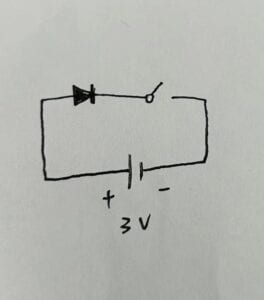
Diagram of the soft circuit
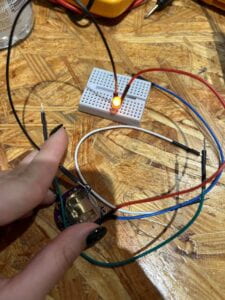
Testing on breadboard
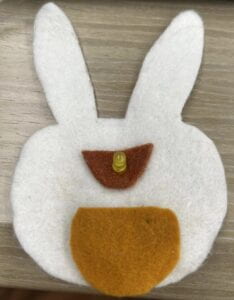
Final output
Sewing process and problems encountered:
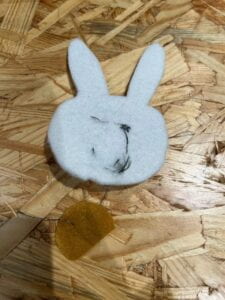
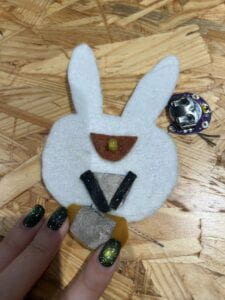
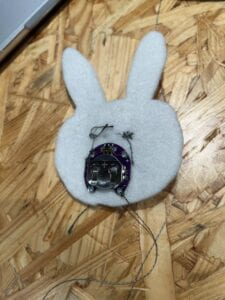
Since I didn’t have experience sewing before, I struggled a lot with sewing at first. I asked Marcela and also referred to the tutorial video. However, it still took me a lot of effort to sew correctly.
After cutting the fabric to the shape of a rabbit, I had problems connecting the thread to the LEDs. I asked Marcela for help and sewed the LED into the fabric. The rabbit’s mouse serves as the button. There are two layers of conductive fabric in between the mouse. When clicking the button, the LED in the rabbit’s eye will light up.
When I first sewed to connect the battery to the LED, I found that the LED automatically lit up without me pushing the button. I immediately realized I connected the circuit wrong and did not create a break in the circuit though I thought I did. I went back to my sewing and I realized that I directly connected the positive and negative poles of the battery to the two bars of the LED. So I unsewed the thread linking the positive side of the battery and sewed it again to the button. Therefore the break in the circuit is the mouse. When I press the mouse, which is the button, the conductive fabrics touch each other and the circuit is complete. Then I ultimately created the right circuit path. 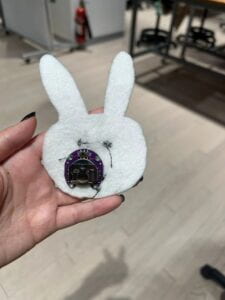
Another small problem is that I chose the softer white fabric this time and it is very difficult to sew and maintain. Perhaps the harder fabric will be better.
Blog Post Questions
If you need to turn on two LEDs, what circuit would you use and why? Test the circuits and explain what is happening and why.
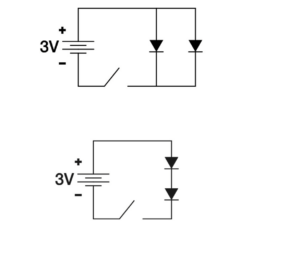
If I need to turn on two LEDs, I will use the first circuit, in which the LEDs have parallel connections with the power. In the parallel connection circuit, the two LEDs have the same voltage as the battery(3V), so they both have enough power to light up.
The second circuit, however, is a series connection. The two LEDs separate the voltage provided by the battery and share a total amount of 3V, so neither has enough power to light up.
Reading Reflections
- What is fashion for you? and why are you interested in fashion?
For me, fashion is an expression, attitude, and a notion of self-care. It is a way to communicate my personality, interests, and creativity through clothing and accessories. It can also be an attitude, reflecting individual tastes and preferences. Additionally, fashion is often viewed as a means of self-care, as the act of dressing well and feeling confident in one’s appearance can contribute to overall well-being. Fashion can empower people. These are the reasons why I’m interested in fashion. Through fashion, I can sense people’s different styles, lifestyles, and attitudes. Fashion is constantly changing but sometimes goes back to a cycle. Fashion serves as a dynamic and ever-changing form of cultural expression that allows individuals to convey a sense of identity and belonging. Fashion is also associated with ecology, exploitation, etc. Therefore, it is a topic worth researching about.
- What kinds of things do your clothing say about you and your values?
I don’t have a specific clothing style, and I often wear different styles of clothes. However, when I was young, I wore very cute, girly, and pink clothes, but I don’t do so anymore. I’d say this shows how my mindset and values change over time. I grew up and this change indicates the transformation of my self-identity. In Do Clothes Speak? What makes them Fashion?, Fred wrote that “what we wear is characterized by tensions over gender roles, social status, and the expression of sexuality”(2). I can really identify with this. Now, through my clothes, I’m trying to show myself as an independent and cool woman. The different styles of clothes I have in fact imply the different characteristics I have. Since I began to street dance, I tend to wear hip-hop and confi clothing more, and this reveals my value of living freely and enjoying the moment of life.
- What are your main learnings and takeaways from the readings?
One idea that raised my thoughts was in Davis’s book about the private self vs. public persona(6). He discusses how clothing can be said to function as a visual language and also like music(5). Clothing is coding. What we wear inputs something and results in an output, which might be our impression to others. Fashion can definitely showcase our private self, as we can wear anything we want. However, for Chinese students, we had to wear uniforms before university and this reveals our public persona: a good student. Davis discusses that clothing’s meanings are cultural(15). It is associated with social status and economy. By looking into the fashion of something, we can learn a lot about its cultural background. Fashion is not only about a distinctive style but also links to change and fabrication(16). This echoes to my main takeaway from Ying Gao’s Interactive Fashion Doubles as Cultural Critique. The main word in this reading is definitely “innovate”. To Ying, what matters is” the concept of the foreign, the dissimilar, and the different.” Nowadays, when fashion is connected to technology, there are many ways to innovate, either through the biology angle, or the architecture side, etc. Fashion” encounters with time.” Her works using different sensors in an unconventional way really inspired me. She using sensors to interact with strangers and feel the gaze is indeed innovative. I can really learn from her spirit of breaking the norm.
References
Davis, Fred (1992) ‘Do Clothes Speak? What makes them Fashion?’ in: Fashion, Culture and Identity. Chicago: The University of Chicago Press, pp. 1–18